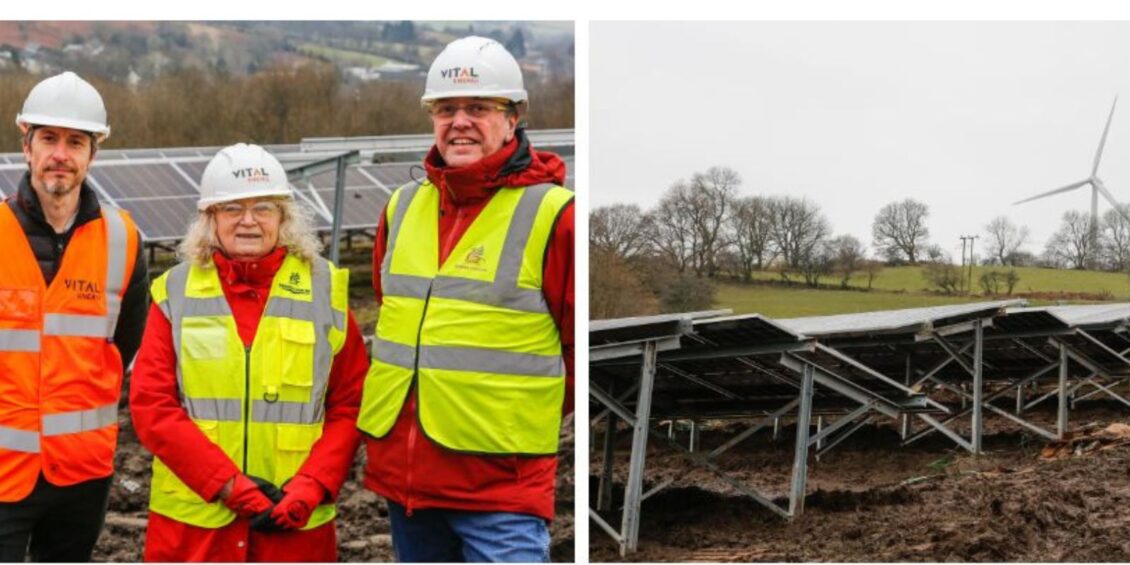Councillor Tina Leyshon and Councillor Mark Norris of Rhondda Cynon Taf County Borough Council recently met with representatives from Cwm Taf Morgannwg University Health Board and Vital Energi to celebrate the start of construction on the Coed Ely Solar Farm.
The project involves the installation of 9,408 solar PV panels, which will contribute to a lifetime carbon saving of approximately 7,355 tonnes. Once completed, the solar farm will generate enough clean electricity to power around 8,000 homes in the local area.
A key aspect of the initiative is an innovative power purchase agreement, enabling Royal Glamorgan Hospital to source electricity directly from the solar farm, significantly reducing its carbon footprint.
Developed in partnership with Vital Energi, the project plays a crucial role in helping the Council achieve its 2030 net zero targets. It will also support Royal Glamorgan Hospital’s decarbonisation efforts by supplying 1MW of low-carbon electricity through a private wire network.
Councillor Tina Leyshon, Cabinet Member for Corporate Services, Youth Participation, and Climate Change, emphasised the significance of the initiative:
“It’s fantastic to see the progress on this project as we see the journey towards completing the Coed Ely Solar Farm begin. This ambitious project is providing a unique opportunity to deliver green energy at a significant scale, feeding energy directly into the National Grid and supporting the energy security of our community and the UK.”
“By supplying the Royal Glamorgan Hospital with low-carbon electricity, we’re helping to reduce its carbon footprint, making the project even more beneficial and directly supplying our local NHS.”
“Additionally, with the site’s reclaimed colliery tip unsuited for agriculture, this project shows how land can be repurposed for clean energy while still supporting local biodiversity. Grazing rights for animals will continue, demonstrating that solar energy projects can coexist with farming and enhance biodiversity.”
Mark Williams, Partnerships Director at Vital Energi, highlighted the project’s innovative approach:
“As we transition from fossil fuel to a low-carbon society sites like this former coal tip can be repurposed and continue to contribute to the UK’s energy infrastructure, but in a renewable way. This project is also a fantastic opportunity to invest locally by engaging with local subcontractors, adding to our Wales-based employees and apprentices as well as partnering with a range of local causes so that in addition to delivering an important project, we can leave a lasting, impactful legacy.”
Linda Prosser, Executive Director of Strategy and Transformation and Executive Lead for Decarbonisation at Cwm Taf Morgannwg University Health Board, spoke about the hospital’s sustainability progress:
“We are delighted that on peak summer days the whole hospital will be powered by solar energy. This will have a significant positive impact on our decarbonisation and ‘Green CTM’ commitments and how we can deliver healthcare in a sustainable way for future generations. However, this scheme is not the end of the story at the Royal Glamorgan Hospital and we will be delivering more renewables and low carbon technologies in future to further decarbonise the hospital’s energy demands.”
“Additionally we are proud to work with our partners at RCTCBC and believe that this scheme is a great example of positive collaboration and partnership working between Health Board and Local Authority.”
Delivered in partnership with Vital Energi, the Coed Ely Solar Farm project reinforces Rhondda Cynon Taf’s commitment to sustainable energy solutions.
In addition to the solar farm, Vital Energi will install essential supporting infrastructure, including:
- Substations and inverters to manage electricity distribution
- A private wire network connecting the solar farm to the hospital
- A 2-metre-high security fence and CCTV to ensure site security
By transforming a former coal tip into a renewable energy hub, the Coed Ely Solar Farm represents a significant step forward in creating a greener, more sustainable future for the region.









Leave a Reply
View Comments